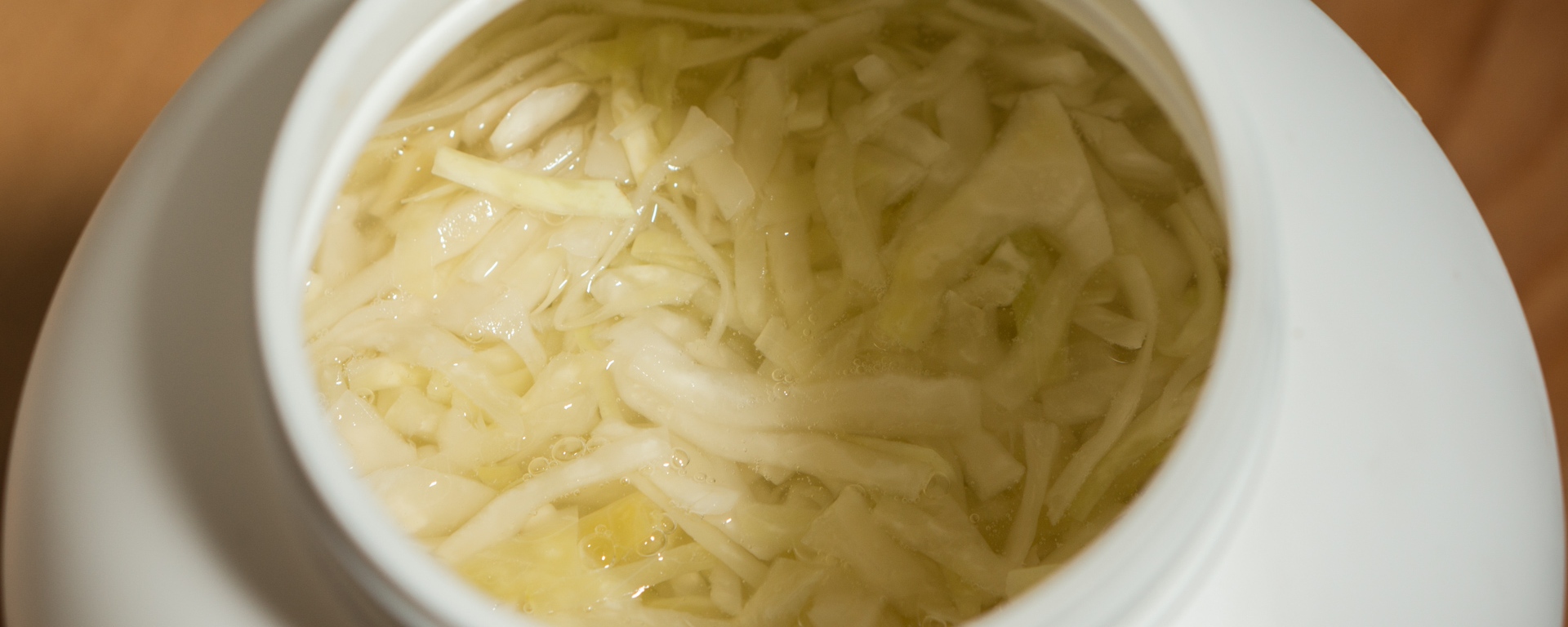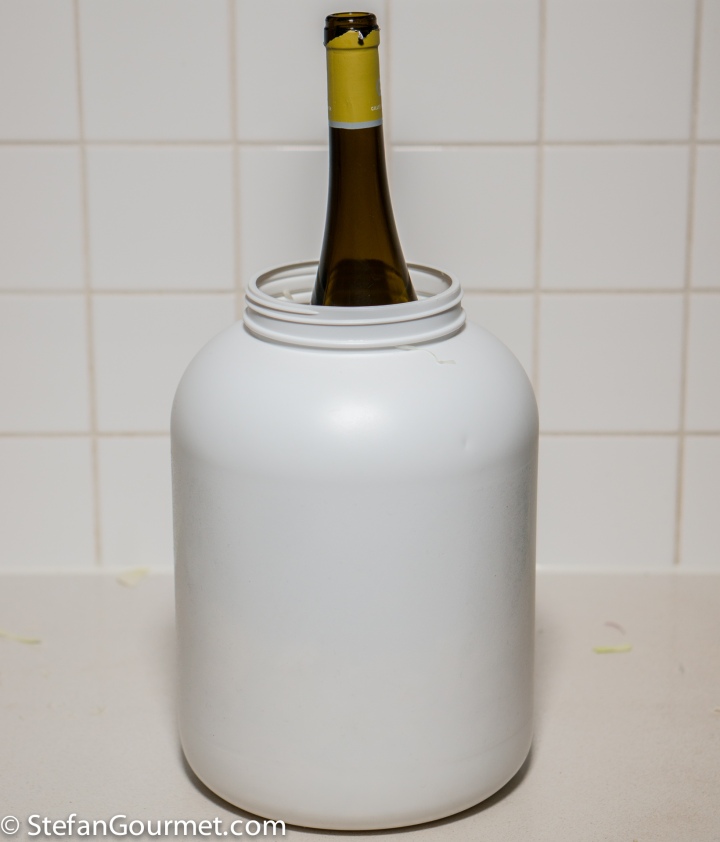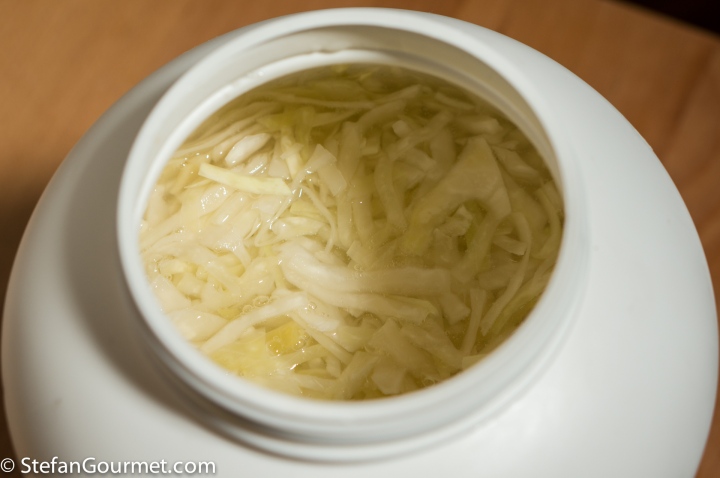Before we had refrigerators, airplanes, and greenhouses, fresh vegetables were hard to come by in winter. And so our ancestors developed many ways to preserve vegetables for the winter. Even though it is not a necessity anymore, we keep preserving vegetables because we like the flavors.
An important example in Dutch (and other northern European) cuisine is sauerkraut (zuurkool). Cabbage is shredded and salted and put in a container to ferment. The lactobacillus that are naturally present will turn sugars in the cabbage into lactic acid, thus preserving the cabbage and giving sauerkraut its characteristic flavor. Once fermented, it will keep the whole winter in the cellar.
Nowadays we can buy sauerkraut in the supermarket, but it is more fun and more delicious to make it yourself. I had never done so yet, but it turns out to be quite easy. The only ingredients you absolutely need are cabbage and salt. You could add optional herbs and spices (like bay leaves and juniper berries) or white wine. And you could get the fermentation started by adding some buttermilk or yogurt, but that really isn’t necessary.
The cabbage has to be mashed and bruised to get the fermentation going, which was quite a bit of exercise. But it was worth it, as the resulting homemade sauerkraut had a milder and more complex flavor than store-bought sauerkraut.
Ingredients
white cabbage
salt, 15 grams per kilo or 1 teaspoon per pound
Instructions
Do not wash the cabbage, but simply discard the outermost leaves. Cut the cabbage into quarters.

Cut the quarters into wedges, and remove the tough central trunk.
Slice the cabbage thinly, which is the easiest when using a food processor or a (large) mandolin.
Put a layer of salt in a container, and then a layer of cabbage.
Bash and bruise the cabbage until it is flattened and starts to release liquid. I used a bottle with a flat bottom for this.
Keep going until you have filled the container or used up all the cabbage. Finish with a final layer of salt. I was surprised that all 4 cabbages fit into the single container.
You are supposed to keep bashing the cabbage until enough liquid has formed. I got tired of the bashing after an hour or so, and decided to add some dry white wine instead (riesling would be the most traditional choice).
You are now supposed to put something heavy on top of the cabbage to keep it submerged. The cabbage will only ferment when it is not exposed to oxygen. Since the opening of the container I used wasn’t large enough, I skipped that step and decided to stir the top layer once in a while instead.
Close the container. Keep it at room temperature for some days until the fermentation starts (which you can smell and/or see). Then continue the fermentation in a cooler spot, like a cellar or garage. Keep going until the sauerkraut is to your liking. In my case it took 6 weeks. Check on the sauerkraut every week or so. If any mold appears (which didn’t happen in my case), that is not a problem. Simply skim it off.
You can now take out what you need, and then close the container again. It will keep all winter in the cellar or garage (around 16C/60F).
Sauerkraut can be eaten raw or it can be eaten cooked. You can find a great way to prepare it here.
Flashback
Truffle risotto is a simple yet decadent dish that is perfect for this season. Just make sure you use real fresh truffle and not chemical truffle oil from a bottle.













Buonissimo. La mia amica faceva una cosa simile col cavolfiore!
LikeLiked by 3 people
Interesting story behind this interesting recipe🙂
LikeLiked by 2 people
loved reading this
LikeLiked by 2 people
Fantastic!! Have never made it myself and have to wait until winter as even the night-time temperatures here are above 20C at the moment 🙂 ! And you totally forgot about the word ‘probiotic’ in relation to this healthiest of dishes [laughter!] which together with pickled cucumbers and beets and all things else was mother’s milk for me! I don’t know about the Netherlands, but one cannot have Christmas without sauerkraut amongst the Baltics or Scandinavia – be it with goose or duck or fatty pork and naturally black pudding and pig blood cakes – of course made with oodles of lard and sugar [hmmm!!] . . . I love mine raw and the juice is wonderful . . . shall try homemade for sure . . .
LikeLiked by 2 people
Hey Stefan … I don’t know if you saw my post on homemade sauerkraut back on November 5, or not. That was actually a batch I made at least a month or two before the post date.. Since then I made another batch and I *did* add some white wine but only after the main lactic acid ferment seemed to have ended. The taste was terrific… However, I was hesitant to add wine before ferment as I assumed the sulphites generally used by winemakers to halt fermentation might be a problem. It is interesting to see your result!
LikeLiked by 2 people
Hi, I did see your post and thought I had commented as I thought it was quite a coincidence that you were posting about this while my batch was fermenting. I do most of my blog reading and commenting on the train, so sometimes comments get lost because of a bad connection. Good point about the sulphites. Winemakers should only use a minimal amount to avoid headaches, but it could indeed slow down the fermentation.
LikeLike
I have heard it is quite the waiting time to make this. I have several co-workers (both of German descent) that make large batches of this every year.
LikeLiked by 2 people
Hi Stefan.
I grew up with home made sauerkraut, which was omnipresent in Swabia.
My mom (with the help of my dad) made it every year. It was on the table at least once a week. We kids also liked to eat it raw 🙂
Btw, add wine and it is called “Winekraut”
In Swabia, we love to use the local “Filderkraut”, which is cone-shaped. When using filderkraut, the end product is much more refined than sauerkraut made with ordinary white(round) cabbage. The final product is also called filderkraut. If you have a chance, try it, you will surely appreciate it 🙂
Cheers !
LikeLiked by 2 people
Stefan Welcome to the world of fermentation. It’s been a game changer for me. Check out the Wild Fermentation FB page. There’s so much info there. One important thing in ferments is the % of salt. For kraut it should be about 2%. Try also some spices. Pepper fennel cumin -really anything you like but just not the whole kitchen sink.
LikeLiked by 1 person
Good on you, Stefan, for tackling this. I’ve read about the process a number of times but shied away from the challenge. One of these days I may give it a try but, until then, I’ll stick with one of the locally produced Polish vesions. 🙂
LikeLiked by 1 person
Interessante … anche per la storia
LikeLiked by 1 person